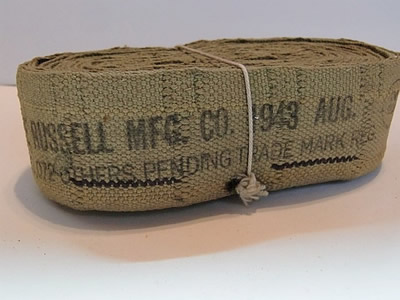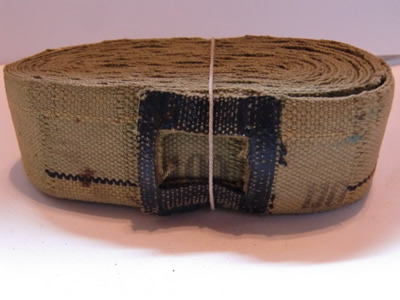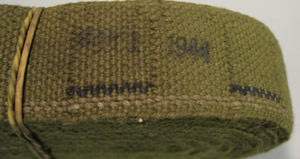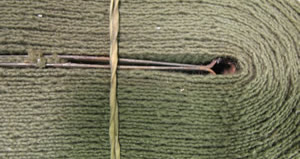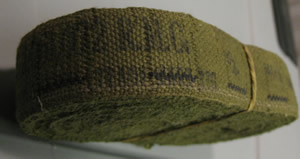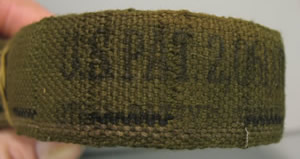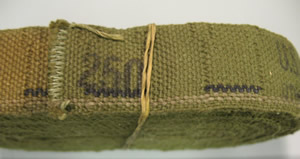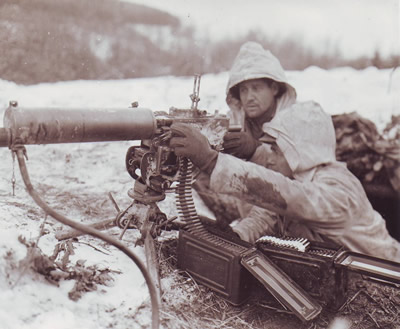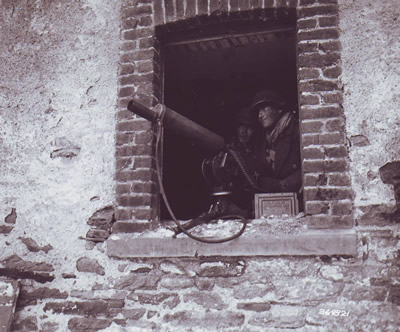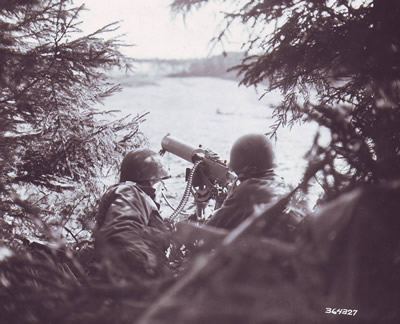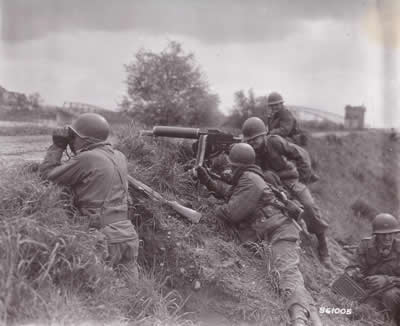Brief Notes on the Production and Use of OD7 Browning Belts in WWII
Author: Tom Kelly
Date Written - 1/12/2013
Introduction Generally reenactors share an aversion, and some times, a disgust for the use of late war olive drab (so called OD7) gear. As I typically reenact a U.S. Army unit in late 1944 and early 1945 I have preferred to use OD7 gear in my impressions. I feel comfortable with using 1943 dated pieces which have been constructed in this shade, and I am often at odds with many others in the community. When I purchased my Browning 1919a6 and began conducting photographic research on its use I stumbled upon pictures of machine gun crews late in the war using what were undeniably OD7 belts. Those pictures led me to look deeper into the subject and to write this brief article on the use of these belts in the ETO during 1944 and 1945.
This article is not intended to be an all encompassing analysis of belts made for Browning machine guns during the Second World War. Rather, it is a compilation of what little research has been done on the production and use of olive drab cloth belts in 1919a4 and 1919a6 machine guns, combined with original photographs and my own personal observations. A more detailed analysis on the development of these belts can be found here. As such, this article contains few citations and is mainly written in generalities. My hope is that with more research and accumulation of original samples, or with discussion that this article may create, it can be revisited and revised later.
Production
By 1943 the U.S. Army Quartermaster and the multitude of civilian contractors producing webbing for the war effort were experimenting with darker shades of webbing. The purpose of this gradual change of color from khaki (or OD3) to green (OD7) was to provide better camouflage. It is not surprising then that production of cloth belts for machine guns, thereto produced in white cotton, incorporated this change.
At this point production numbers, variations, and specific dates on which this change was implemented do not exist. From original examples we can tell that OD belts began being utilized in .50 caliber cloth belts as early as 1943. Because manufacturers typically produced both .50 and .30 caliber belts it is extremely likely that OD .30 caliber belt production occurred concurrently with those in .50 caliber.
Coinciding with this change in color was an overall change in production of cloth belts. By December 1943 the Army drastically reduced its contracts for belted machine gun ammunition, similarly the production of belts ceased in May 1944.
“so much functional lot belted ammunition was produced in WWII that production actually slowed to a trickle at the end of December 1943 and several ammunition plants converted from .30 caliber ammunition production to other ordnance materials…Likewise, fabric belt production halted in May of 1944 but resumed after the German winter offensive in the Ardennes Forest of Belgium better known as the Battle of the Bulge in December 1944/January 1945 concluded.” http://m1919tech.com/26513.html
During the Battle of the Bulge the Army contracted again for belted ammunition, and original examples of 1945 dated cloth belts seen by the author have been all been OD.
Example of 1945 dated cloth belts for the .30 caliber machine gun, note the phosphate coated starter tabs. From www.AmmoGarand.com
The likely low production numbers of these OD belts has caused them to be very hard to find in any condition. However, given the recent availability of 1945 dated OD belts from it is clear that after 1943-44 .30 caliber cloth belts were produced in OD.
Use
The following collection of photographs are from the National Archives Research Administration (NARA) located in College Park, MD and were scanned by the author, any other sources are cited.
The photographs below, which are all dated 1944-45 show OD cloth belts in use with .30 caliber machine guns. From this relatively small sample a conclusion that these belts saw use, and possibly extensive use during late 1944 and early 1945 as the Army expended its surplus of belted .30 caliber ammunition, can be hypothesized.
“Two 5th Division infantrymen load their .30 caliber Browning machine gun in a position near Brandenburg, Luxembourg. Left to Right, Sgt. Lawrence R. Thorn, Alba, Tex.; and Pfc. Preston Erwin, Nazareth, Pa. January 27, 1944.”
This is a good representative photograph of a heavy machine gun crew in early 1945, note the use of both white and OD belts.
“Pfc. Gerald A. Cohan, 9 Shew Ave., Newark, NJ, mans a .30 caliber machine gun covering the approaches to Salmchateau as the 75th Division takes the town. January 16, 1945.”
“Prum, Germany. Machine gunners from Company ‘M’ 22nd Infantry Regiment, 4th Infantry Division, U.S. 3rd Army, lay down harassing fire at Germans on the outskirts of the Siegfried Bastion. February 22, 1945.”
“An advanced guard at the outpost near Braunau. These men are scouting the enemy for the 13th Armored Division, U.S. 3rd Army. May 2, 1945.”
Conclusion
Admittedly the research on this subject is insufficient to draw many conclusions, but it there is enough to substantiate the wartime production and use of these belts in combat in the ETO in early 1945. While it may not be entirely appropriate to use an OD belt in a Normandy scenario, it would certainly be appropriate to utilize them in any 1945 dated impressions.
90th IDPG Weapons



